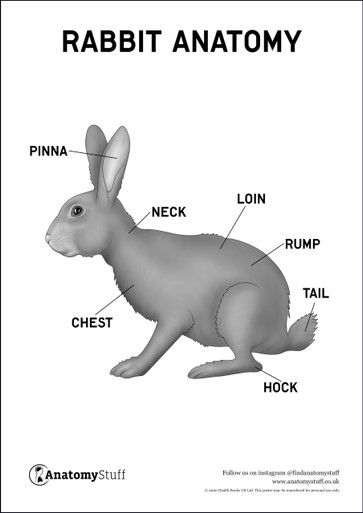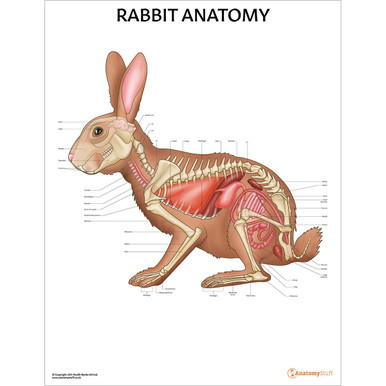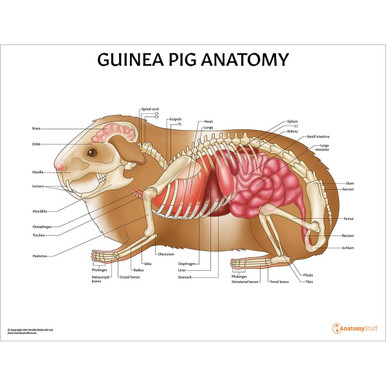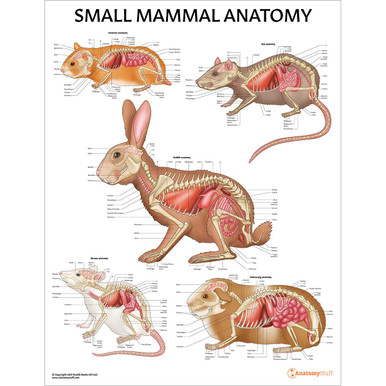Small Mammal Anatomy
There are many small mammals that exist in the world. We will be focussing on five small mammals that are domesticated and belong to the Rodent family including the hamster, mouse, rat, guinea pig, and the Leporidae family, including the rabbit.
Rodent Anatomy
This part of the blog will focus on rodent anatomy as they all have very similar anatomical structures.
Mice, rats, guinea pigs and hamsters are known as rodents. Rodents can be subdivided into myomorphs and hystricomorphs. Hamsters, mice and rats are classed as myomorphs because they are omnivores. Guinea pigs are classed as hystricomorphs because of their ability to take care of their young and because they are herbivores.
Rodents have a single pair of incisors that continue to grow throughout the mammal’s lifespan. They have strong jaws which allow them to gnaw and chew food effectively. Their spines usually have similar amounts of vertebrae apart from the tail which varies in each rodent. There are seven cervical vertebrae, thirteen thoracic vertebrae, six lumbar vertebrae and 3-4 fused sacral bones.
Hamster Characteristics
Hamsters have bodies that are adapted to burrowing underground. They have small, strong feet and a small tail. Their eyesight is adapted to low levels of light and they have very poor eyesight in bright conditions. Hamsters have great hearing and sense of smell which makes up for their lack of good eyesight.
Another specialised characteristic of the hamster is their ability to hold large amounts of food in their cheek pouches which can extend from their mouth to their shoulder. Hamsters have great dexterity in their front paws which allows them to feed and groom themselves easily.
Rat Characteristics
Rats are similar to mice but they are larger in size. They have erect ears, protruding eyes and long tails. Rats have four toes on their forefeet and five toes on their hindfeet. Rat tails have a specialised job in thermoregulation and their tails can also help with their sense of body positioning.
Rats have an excellent sense of smell. One reason for this is the well-developed olfactory receptors. When a smell is detected, the molecules bind to several receptors which increases the ability to smell odours. The presence of the vomeronasal organs located in the nasal cavity allows rats to detect smells related to social and reproductive behaviour.
Mouse Characteristics
Mice have very similar anatomy to the rat except they are smaller in size. Mice are good jumpers, climbers and can swim. They use their tail to help with balance. Similar to other rodents, mice have poor eyesight but are able to rely on other senses such as hearing and touch
Guinea Pig Characteristics
Guinea pigs have short legs, a stocky body and a large head. Their eyes are located on the sides of their head which means they have excellent peripheral vision. Guinea pigs can communicate with each other and humans through vocalisation. They make specific noises to communicate how they are feeling. Guinea pigs are herbivores and live together in herds in the wild.
Free PDF Downloads
View AllRabbit Anatomy
Rabbits belong to the Leporidae family alongside hares. Rabbits used to be classed as rodents as their incisors continue to grow throughout their lifespan however, they are now categorised into a separate family. Leporidae and rodents are sister groups as Glires is a common ancestor that they share.
Rabbits have a similar skeleton to rodents but have a few features which make them more distinguishable. They have seven cervical vertebrae, twelve/thirteen thoracic vertebrae, seven lumbar vertebrae, four fused sacral vertebrae and sixteen caudal vertebrae. Rabbits separate themselves anatomically through rodents is the presence of two sets of incisors rather than one set.
Rabbits have strong hindleg musculature which helps to propel themselves forward when moving. The quadriceps provide the power for the humping motion. The hamstrings provide short bursts of movement. The plantar flexors and dorsiflexors also assist with providing movement of the hindlimb.
Rabbit Characteristics
Rabbit ears are long in comparison to other small mammals which allow them to hear any danger or predators from far away. Rabbits are social and they live together in herds in the wild and they are herbivores. They are prey creatures so they are always alert and aware of their surroundings to avoid danger. They are able to run for long distances and at high speeds when they need to escape from predators.

















